Starting your first LinkedIn advertising campaign can be tricky. The platform’s ad management functionality differs from other platforms, like Facebook and Twitter, but it also has several excellent tools to target your ideal audience.
LinkedIn’s value for advertisers is its powerful interest-targeting capabilities. For example, you can target LinkedIn members based on the information stated on their profile, such as their job title, job seniority, skill-sets level, current company, industry, and more.
Think you’re ready to build your first B2B LinkedIn campaign? Here are the steps to take to achieve success.
Setting Your Campaign Up for Success
Before you choose your campaign objective, first establish the main Key Performance Indicator (KPI) you want to track, and measure within your campaign.
LinkedIn provides three objective pillars to help you find the objective that best aligns with your KPI goal.
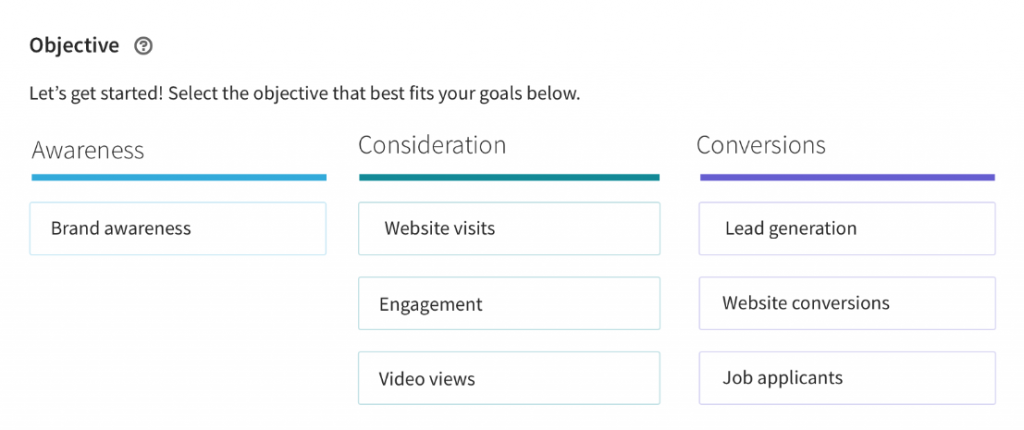
Once you’ve selected your objective, you can then determine what metrics you should be tracking to measure success. Here’s a quick breakdown:
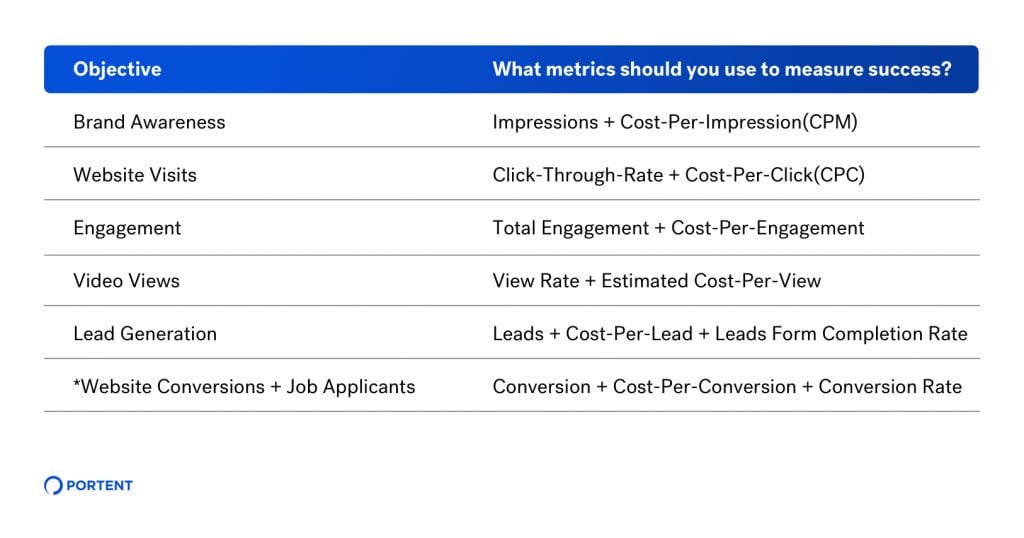
How Can You Add Conversion Tracking to Your Campaign?
You will first need to implement conversion tracking by enabling your site-wide Insight Tag. For reference, an Insight Tag is when you add a LinkedIn tag within your website to track visitors. Or, if you are tracking by event,(i.e., button click) you will need to install the code on the backend of your website or within a tag manager platform. Once you created a conversion tracker, you will need to assign it to the campaign(s). You can add the conversion tracking, which is located on the bottom of the page when you create a campaign.
![]()
Targeting and Segmentation Opportunities
You should only implement LinkedIn’s targeting capabilities once you understand how to use them effectively. If you don’t know how targeting efforts work on LinkedIn, you may struggle to find audiences that convert well on your campaigns. In this section, we’ll learn how to avoid making mistakes.
Matched Audiences
Matched Audiences consist of website visitors retrieved by the LinkedIn Insight Tag or customer lists uploaded onto the platform. (Note: these audiences are typically small, so make sure to combine audiences, such as all customer lists or website visitors, to build a bigger targeting pool.)
Once you establish your Matched Audiences, they can then be used to create lookalike audiences, where LinkedIn will find similar audiences based on these criteria. These audience sizes are bigger, but in our experience, We found that CPM is relatively higher compared to interest audiences.
Interest Audiences
In our experience, Interest Audiences is the best targeting capability within the platform because the CPM and CPC are less costly. With Interest Audiences, LinkedIn’s algorithm can target users based on their profile, which users update frequently. With this targeting option, one key element you must keep in mind is when you should use the “AND” or “OR” functionality within the platform.
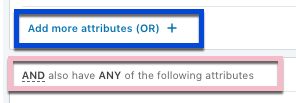
Using the example below, you should use the “OR” function to find audiences at the executive level (e.g., Job Seniority) as well as audiences whose current job titles include Agricultural Engineer, etc. The “AND” function is used to notify LinkedIn to find audiences who meet the criteria above (Job Seniority/Job Title) only if they work in the selected industries (e.g., Agricultural Industry).
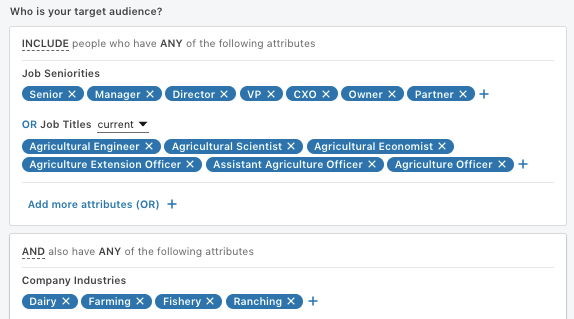
Here are a few Dos and Don’ts when targeting on LinkedIn:
- Do keep your targeting broad when creating your first campaigns. This will allow you to understand what type of users are viewing, clicking, or converting through your ads.
- Don’t overly-narrow your audience when creating your first campaigns. You want to accumulate as much insight as possible, such as who is viewing, clicking, or converting on your ads.
- Do combine targeting options to find the right audience. For example, if you select Job Seniorities, you want to combine it with either Job Functions, Company Industries, Member Skills, etc. (e.g., Job Seniority: VP and Director level with Job Function: Engineering).
- Don’t target everyone. By doing this, you will show your ads to users on the platform who may not be your target customers. This will result in not using your budget efficiently, which can, in turn, be a waste of money if those users do not become customers.
- Do exclude current employees and competitors. This will help you use your budget more efficiently.
- Don’t overly-narrow your exclusions. As mentioned before, if you narrow your audience in the beginning, there will be missed opportunities in reaching potential audiences.
Promote Content that Resonates with Your Audience
It is crucial to test creatives (depending on the ad format you choose) within the ad to identify what type of content resonates best with your audience. But how can you promote the best content for your audience? Let’s use the Direct Sponsored Content (DSC) ad format as an example.
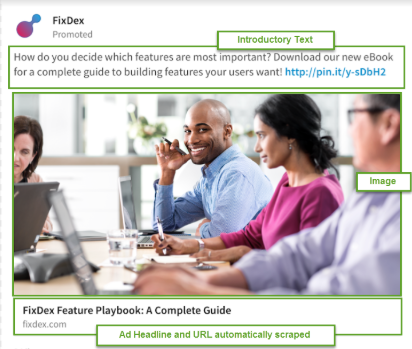
With DSC as an example above, you can evaluate different components within the creative such as messaging, landing page, and image/video to find the right content that resonates with your audience. The best way to find this is to test different variations within the creative.
Below are vital steps and an example of what you should test, and how:
- Always test at least two versions of ads. This allows you to get insight into what type of content is performing best.
- Make sure the content on your ad matches the landing page.
- When testing ads, you need to test at least one variation of creative. Using the DSC ad format as an example, here are different variations you can test within the platform:
- Creative A: Ad Copy 1, Image A; Creative B: Ad Copy 2, Image A
- Creative A: Ad Copy 1, Image A; Creative B: Ad Copy 1, Image B
- Creative A: Ad Copy 1, Image A, Landing Page 1; Creative B: Ad Copy 2, Image A, Landing Page 2
Measurement and Optimization
Lastly, while your campaigns are running, regularly monitor performance based on your main KPI goals.
Here are a few key points to measure and optimize your campaigns effectively:
- Run campaigns for at least two weeks to retrieve significant data insights.
- Pause underperforming ads within your campaign and create new ads to test based on what is performing well.
- Ensure that you are switching up your ads often. I recommend at least once or twice a month.
- Ensure you are testing different audiences. This will allow you to measure the effectiveness of the audience and optimize performance based on the insights you’re seeing.
- Make educated decisions based on your main KPI goals which help you identify whether your campaign, audience, or ads are working or not. One way you can evaluate performance is by using LinkedIn’s tool called Demographics. You can find this tool on the top menu bar within Campaign Manager. This feature showcases demographic information (e.g., based on Job Function, Job Title, etc.) of your audience who viewed, clicked, or converted on your ad. By using this tool, you can analyze audiences and optimize your campaign based on your findings.
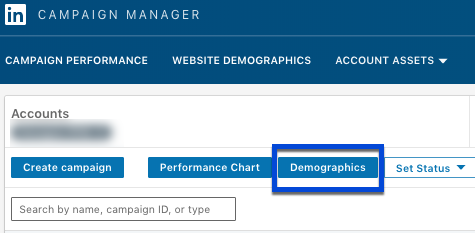
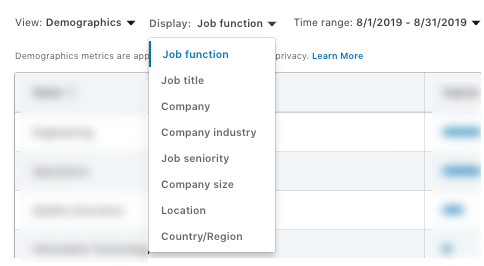
To Recap
Before you begin advertising on LinkedIn, start by identifying your KPI goal. You’ll be better equipped to evaluate performance based on your campaign objective, targeting, and ads. Be sure to set up conversion tracking, and explore targeting and segmentation opportunities once you are familiar with them. Make sure your content is appropriate for your audience, and assess your campaign’s performance by testing and optimizing. This means testing different targeting efforts, creatives, and pausing underperforming campaigns.
And there you have it. Now that you’ve learned the fundamentals of LinkedIn, you’re ready to start advertising.









